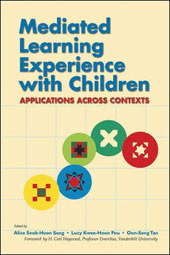Why Singapore’s English Teachers Should Embrace Singlish, Not Fight It
Is it time for Singaporean educators to embrace Singlish as a legitimate learning tool? What the Research […]
Read More
Edited by Alice Seok-Hoon Seng, Lucy Kwee-Hoon Pou and Oon-Seng Tan (2003), McGraw-Hill Education (Asia), ISBN: 0-07-123217-6, 210 pp.
“Intelligence is not a static structure, but an open, dynamic system that can continue to develop throughout life.” – Dr. Reuven Feuerstein
This book is a great read as it provides a fresh look at the concepts, theories and applications of Mediated Learning Experience (MLE), a theory based on the work of Reuven Feuerstein.
The first section of the book explores the four theoretical aspects of MLE. This includes the following:
 The first chapter of the book provides a comprehensive explanation of the theoretical framework of MLE. It offers different scenarios to help readers better understand the foundation on which MLE is built upon. Besides looking into the basic theoretical framework of MLE, this chapter also examines theories developed by Piaget, Vygotsky and Feuerstein and relates them to the functions of MLE.
The first chapter of the book provides a comprehensive explanation of the theoretical framework of MLE. It offers different scenarios to help readers better understand the foundation on which MLE is built upon. Besides looking into the basic theoretical framework of MLE, this chapter also examines theories developed by Piaget, Vygotsky and Feuerstein and relates them to the functions of MLE.
As this first chapter is introductory, it is crucial for those who have little or no idea about the theoretical concepts of MLE to read this it first in order to grasp the concepts in the later chapters, where MLE is explored in greater depth.
The book’s next three chapters explore the other theoretical aspects of MLE such as the multi-dimensional meta-theoretical framework and the multidimensional modifiability. The insightful descriptions provide readers with a better understanding of the theories and frameworks underlying MLE.
The latter part of the book focuses on the application of MLE across different domains. In particular, it deals with specific groups of people such as preschool children, children with disabilities, and even parents (as they too have an important role to play in the application of MLE). The book presents the techniques and strategies of MLE as well as their results and implications, so readers have a clearer picture of the kind of results to eapect if they were to try out MLE for themselves.
The last chapter of the book discusses some test tools such as the Children’s Analogical Thinking Modifiability (CATM) Test, the Children’s Inferential Thinking Modifiability (CITM) Test and the Complex Figure Test. All these are available for the assessment of children’s cognitive abilities.
Overall, this book provides readers with a good understanding of MLE and the different pedagogical intervention programmes that are based on its theory and concepts. The book may even inspire some readers to factor MLE into their teaching strategies. However, this book is not an instructional manual so readers who expect a more systematic reference on how to implement MLE may be a little disappointed.